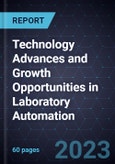Robotics and AI Enable a Paradigm Shift to Remote and Autonomous Lab Work
Clinical diagnostics, life science research, genomics and proteomics, and drug discovery labs are adopting lab automation solutions to overcome tremendous operational pressure because of the demand for high throughput and shortage of technicians. Solutions that automate pre-analytical, analytical, and post-analytical processes are available. The report limits its scope to the lab automation innovations enabling analytical processes.
Most robotic innovations emerging in the industry are liquid handling robots enabling precise liquid pipetting or dispensing. Principal players focus on ease of use, modularity for easy adoption and scalability, and remote operation, monitoring, and maintenance. Most digital solutions supporting lab automation integrate AI/ML algorithms for intelligent imaging, analysis, data management, lab workflow management, and robot operation. Cloud labs provide a cost-effective and time-efficient option for labs to conduct automated experiments on top-quality equipment.
Labs will become remote, autonomous, and unstaffed in the next 5 to 10 years. The technological advances in robotics, AI, microfluidic technologies, and sensors enable significant advancements in lab automation equipment capabilities, allowing various applications to adopt solutions across different sectors. The increasing adoption in emerging markets provides growth opportunities for the lab automation industry. The improvements in the ease of use, competencies, and interoperability of lab software, especially LIMSs, enable the adoption of lab automation solutions.
Questions Answered in the Research:
- What are the benefits and challenges of adopting lab automation solutions?
- What technologies enable the automation of analytical processes in lab workflow?
- What are the growth drivers and restraints of the lab automation industry?
- Who are the participants in the robotics and digital solutions segments? What technologies do they employ, and what are the applications of their solutions? What are their target impact sectors and commercial readiness levels?
- What are the regional trends? What is the technology roadmap? What are funding and M&A trends? What is the industry’s patent filing trend?
- What are the growth opportunities for the lab automation industry?








